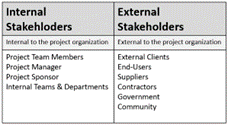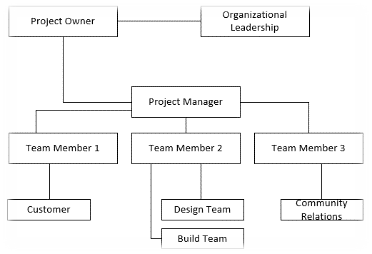
Project Stakeholder Register and Organizational Chart: Useful tools for project stakeholder management
Projects come in all sizes, and in most cases larger projects come with more potential complications. This is also true when projects involve multiple individuals and organizations. Successfully managing a project often means dealing with stakeholders beyond your immediate project team. Stakeholders are key to the success of any project, so identifying and managing stakeholders is a critical element of project management (Kissflow Project, 2021).
Project Stakeholders
Projects frequently involve different groups, individuals, and organizations who may affect, be affected by, or perceive itself to be affected by a decision, activity, or outcome of a project. These are known as project stakeholders (Project Management Institute, 2021). Project stakeholders can be broadly classified into two categories: Internal Stakeholders and External Stakeholders
Internal stakeholders generally include anyone within the organization conducting a project. It starts with the internal members of the project team, the project manager, and the project sponsor. The concept can also be expanded to include other individuals and within the organization or company, such as other teams and departments. Internal stakeholders are usually the easiest to identify because they are immediately known and often familiar.
External stakeholders include anyone affected by the project, its processes, or deliverables and outside of the organization conducting the project. These include external project clients, end-users of product outputs, suppliers, contractors, the government, and sometimes even members of the community where the project is taking place. The complete list of external stakeholders can be more challenging to identify as they can be new to each and every project. And of course, no complete list of stakeholders or stakeholder groups exists for each project!

Stakeholders, both internal and external, need to be identified. A project team should have access to information regarding their roles, responsibilities, and capabilities regarding the project. Stakeholder contact information is also essential to coordinate communication throughout the project and therefore it needs to be available to the core project team.
In addition to knowing who the project stakeholders are, a project team should know how they are organized and structured within the project environment. This is why using a project stakeholder register and organizational chart right from the very start can help to get a clear picture of the project organization and to manage communications throughout the project lifecycle.
The Tools
While project stakeholder management is its own knowledge area and functional discipline, knowing how to use two stakeholder management tools will help to organize stakeholder management for projects of all sizes: the stakeholder register and the project organizational chart.
Advertisement
[widget id=”custom_html-68″]
The Stakeholder Register
A stakeholder register is a document including the identification, assessment, and classification of project stakeholders (Project Management Institute, 2021). It is a list of the stakeholders involved in a project and the “need to know” information about them, kept accessible to members of the core project team.

The first step in creating a project stakeholder register is to identify the stakeholders involved in a project. Start with the internal stakeholders, and then move on to the external stakeholders. Think about who is involved with the project both directly and indirectly. Who might be affected by the project, its execution, and its outcome? What individuals or organizations have authority over different aspects of the project?
Next, determine what information is needed from each stakeholder and start collecting it. This starts with each individual’s name, position, role in the project, and contact information. For organizations and departments, it should include the individual contact person from that stakeholder group. Finally, any other relevant information or details pertaining to that stakeholder or stakeholder group that might be relevant to the specific project at hand.
Finally, compile the register. This can be done in any format the project team chooses to use. A simple spread sheet can serve the purpose, or something more organized like a contact management function in Microsoft Outlook or Google Contacts. Many project management software programs include a resources sheet just for this purpose with customizable fields to organize the details on each stakeholder based on their importance to the project. The most important criteria for the selection of a system to use is that it is accessible to the core members of the project team as they need to use it.
Project Organizational Chart
A project organizational chart is a document that graphically depicts the project team members and their interrelationships for a specific project (Project Management Institute, 2021). It is a visual representation of the stakeholder register indicating how various stakeholders are positioned within the project. A projects organization structure is usually fairly obvious for small projects, but the importance of knowing and understanding the structure becomes more significant as projects grow in size and number of stakeholders. Understanding the organization of the project stakeholders helps in defining relationships, allocating responsibilities, authority, and tasks (San Cristóbal, 2018).

The project organizational chart can be as simple as a tree diagram or a bubble chart. More important than its design is its function and purpose, which is to understand the relationships among and between project stakeholders and to communicate this information at a glance.
Best Practices
With the tools in place, following a few best practices in creating a stakeholder register and a project organizational chart will help in coordinating project stakeholder management.
- Consider Frequent Project Stakeholders
- Start Early
- Involve Others
- Stress Test
Consider Frequent Project Stakeholders
In many organizations, project work is the normal mode of operations. If your organization frequently works with projects, then there is a good chance that many of the project stakeholders, both internal and external, will be the same across multiple projects. Having a list of stakeholders and their contact details ready to go will save time in creating a project register for each project once stakeholders are identified.
Start Early
The process of identifying stakeholders ideally starts once an organization selects and approves a project. By doing so, they can be kept involved, contacted, and consulted as necessary throughout the following stages of project development (Kissflow Project, 2021).
Involve Others
When considering details about individual stakeholders roles, responsibilities, and capabilities, it can be valuable to involve the individual stakeholders themselves, where practical, in collecting these details. This allows for a more complete collection of information and to gain a different perspective.
Stress Testing
Once the stakeholder register and project organizational chart are completed, share them as appropriate with other project stakeholders and members of your organization. As with the process of involving others, it helps to gain a different perspective on the information compiled. Additional feedback will help to improve the accuracy, and therefore the usability, of both tools.
Understanding the needs, structure, and expectations of project stakeholders can be a critically important aspect of achieving project success. Knowing the basics of project stakeholder management, as well as how to create and use a stakeholder register and project organizational chart, will go a long way toward successful stakeholder management in all types of projects.